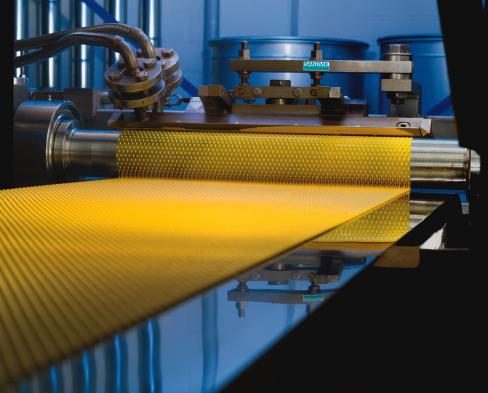With the Rotoform family it is now possible to solidify almost any chemical or food product directly from the melt into free flowing pastilles. The basic principle of the process involves loading the liquid product in the form of droplets onto a continuously running steel belt by means of a specially developed feeding device – the Rotoformer. As the steel belt is cooled from below by means of sprayed water, the product is solidified into pastilles while being transported along the system, before being discharged at the end of the steel belt cooler.
Stefan Gehrmann
The Sandvik Rotoformer permits the production of free-flowing, dust-free pastilles of a uniform size and shape directly from the melt. Subsequent grinding, crushing or other breaking processes are unnecessary. The pastilles are ideal for handling, blending, storage and further processing. The short cooling times – due to the excellent thermal conductivity of the steel belt – mean little vapour or gas can get into the atmosphere and little oxygen can penetrate the product. There is no direct contact between the cooling media (water) and the product. The cooling water is recycled, while the exhaust air is minimal and requires no treatment such as scrubbing or other cleaning.
The process now enables the pastillation of many products which, not long ago, would have proved very difficult or even impossible to form. This includes products with melt temperatures of up to 320 ºC and those of an abrasive, sedimenting or corrosive nature.
Applications
The list of chemical products being formed with the Rotoform process meanwhile numbers more than 300 – from mass products such as sulphur right through to specialist pharmaceutical products – and the same number again have undergone successful testing. The significant benefits provided by the process in terms of hygiene and ease of service mean it is also widely used for the pastillation of food products.
Typical applications include sulphur, waxes, resins, hot melt adhesives, rubber and plastic additives, fatty acid and alcohol, pharmaceuticals, stabiliser, chocolate, cheese, chewing gum base and soup concentrates.
The level of sulphur production is steadily increasing due both to the higher quantities of sulphur found in crude oil and to legislation that demands more efficient desulphurisation of fuel. As a result, liquid sulphur is formed in large quantities for better storage, transport and handling.
The low dust content, low friability, high purity and environmental advantages delivered by the Rotoform process mean that this sulphur is recognised as a high-quality product. One clear indication of this is that Rotoformed sulphur pastilles are allowed to be transported in open trucks or railcars, even over distances of several hundred kilometres. Furthermore, formed sulphur is moved an average of 15 times between solidification and re-use (various transport, storage, handling and re-melting steps), so that a low dust content is absolutely vital.
In the past, resins – primarily used as intermediates for the production of paint and in the electronics industry – were handled in liquid or flake form. Now, having resolved assorted problems (melt temperature up to 320 °C, sticky behaviour, tendency to pick up oxygen from the atmosphere), the Rotoform process is accepted as the standard for solidification of all kind of resins. The best known products in this field are acrylic, epoxy, phenolic, hydrocarbon and polyester resins.
Due mainly to the sticky nature of the melt, hot melt adhesives have to be transported and handled in solid form. The traditional method of solidification was to produce solid strips and then cut them by means of mechanical cutters. The inherent problems of the cutting process (dust, noise, irregular product form) were all eliminated by the introduction of the Rotoform system.
Service
Sandvik works with customers around the world to design and specify the most appropriate solution for a particular product or process requirement. As part of this service, Sandvik operates several test centres where Rotoform systems can be demonstrated and individual products assessed. Mobile units are also available for testing in customers‘ own laboratories and production plants. Sandvik’s objective for the future is to further broaden the range of applications, while simultaneously en- hancing the efficiency of known ones. One example of this is the new Rotoform HS (High Speed), specially designed for high-capacity pastillation of mass products such as sulphur, waxes and fertiliser.
cpp 403
Share:







